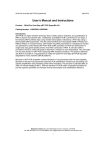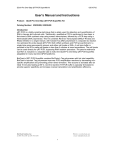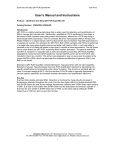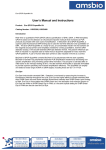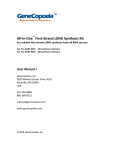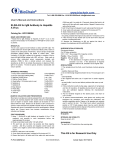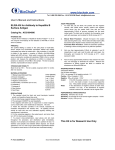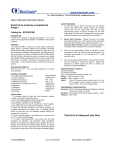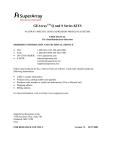Download User`s Manual and Instructions
Transcript
QCell-Pro One-Step qRT-PCR SuperMix Kit User’s Manual and Instructions Product: QCell-Pro One-Step qRT-PCR SuperMix Kit Catalog Number: K5055200, K5055400 Introduction qRT-PCR is a highly sensitive technique that is widely used for detection and quantification of RNA in tissues and cultured cells. Traditionally, quantitative PCR is performed in two steps: a first-strand cDNA synthesis step using reverse transcriptase, followed by a PCR step using a thermostable DNA polymerase. This Kit combines Reverse Transcriptase (MMLV-RTase) and RNase Inhibitor in a single mixture, with hotstart Taq DNA polymerase in a separate 2x reaction mix optimized for probe based qRT-PCR. Both cDNA synthesis and PCR are performed in a single tube using gene-specific primers and either cell lysate or RNA. A cell lysis buffer is provided in the kit to make cell lysates in less than 5 minutes at room temperature. The cell lysate can be used directly for qRT-PCR, bypassing RNA isolation procedure. The passive reference dye ROX is included in a separate tube to make the QCell-Pro One-Step qRT-PCR SuperMix adaptable for many real-time QPCR platforms. BioChain’s QRT-PCR SuperMix contains BioChain’s Taq polymerase with hot start capability. BioChain’s hot-start Taq polymerase improves PCR amplification reactions by decreasing nonspecific amplification and preventing primer-dimer formation. This enzyme is activated after an initial 10 minutes heating at 95°C. And the real-time RT-PCR buffer is specially formulated to provide superior specificity and increase reverse transcription and amplification efficiency. QCell-Pro One-Step qRT-PCR SuperMix Kit 020107V2 216, 36, 6, 1 Y=-3.304Log(x)+31.88, R2=0.999, Efficiency=100.8% Initial Quantity, Cell number Figure 1. BioChain’s QCell-Pro One-Step QRT-PCR SuperMix provides sensitive detection down to a single cell. K562 cells were lysed according to the cell lysis protocol. 6-fold serial dilution of cell lsyate were prepared from 216 cells to 1 cell. GAPDH gene expression was detected using BioChain’s QCell-Pro qRT-PCR kit on Stratagene’s Mx3005P 2 instrument. Efficiency as measured from standard curve was 100.8%, with a R value of 0.999. Features • Flexible and convenient – quantitating gene expression in cells (without isolating RNA) or RNA in one-step format • Save time – quick cell lysis procedure, and ready-to-use supermix reducing setup time and liquid handling steps • High Sensitivity – qRT-PCR from as low as 1 cell or 1 pg total RNA. • Versatile – compatible with a wide variety of cell lines Applications • • • • Real-Time RT-PCR Gene expression profiling Gene knockdown verification Array Validation QCell-Pro One-Step qRT-PCR SuperMix Kit 020107V2 Description Components in this kit are prepared with pure chemicals according to our proprietary technology. QCell-Pro One-Step qRT-PCR SuperMix Kit provides a one-step, simple, robust, inexpensive assay for detection and quantitative analysis of gene expression directly from cells or RNA with probe based format. Quality Control 1 kit of this lot has been tested for quantitating human GAPDH gene expression in a serial dilution of cell lysate from 216 cells to 1 cell using Stratagene’s Mx3005P as a real time PCR instrument. Good linearity and great PCR efficiency is observed and consistent with the previous lot. Components Catalog Number: K5055200: Reagents are sufficient for 200 assays Item 1. Cell Lysis Buffer 2. Pro qRT-PCR Reaction Mixture, 2x (containing Hotstart Taq DNA polymerase) 3. Reverse Transcriptase / RNase Inhibitor Mixture 4. ROX Reference Dye 5. Nuclease-Free PCR Grade Water Amount 20 ml 1.25 ml x 2 Part No. K5055200-1 K5055200-2 100 µl 50 µl x 2 3 ml K5055200-3 K5055200-4 K5055200-5 Catalog Number: K5055400: Reagents are sufficient for 400 assays Item 1. Cell Lysis Buffer 2. Pro qRT-PCR Reaction Mixture, 2x (containing Hotstart Taq DNA Polymerase) 3. Reverse Transcriptase / RNase Inhibitor Mixture 4. ROX Reference Dye 5. Nuclease-Free PCR Grade Water Amount 40 ml 1.25 ml x 4 Part No. K5055400-1 K5055400-2 100 µl x 2 50 µl x 4 3 ml x 2 K5055400-3 K5055400-4 K5055400-5 QCell-Pro One-Step qRT-PCR SuperMix Kit 020107V2 Reagents and Equipments Required but not Supplied in this Kit: 2+ 2+ 1. PBS (Ca , Mg free) 2. Spectrofluorometric thermal cycler Storage and Stability Upon receipt, store all components at -20 ºC in a constant temperature freezer. Avoid repeated freeze/thaw cycles. When stored under these conditions the supermix is stable for one year after ship date. The ROX reference dye is light sensitive and should be kept away from light whenever possible. Protocol Primer and Probe Design Design QPCR primers to generate amplicons of ≤150 bp. Since the cell lysate contains genomic DNA, the primers and probe should be designed to amplify cDNA but minimize amplification of genomic DNA. It is useful to choose primers or probe that span an exon-exon boundary in the target mRNA, or choose primers that flank a large intron. If possible, design primers and probe to avoid regions of secondary structure in the mRNA. Since reverse transcription and PCR are performed in one-step, we recommend to use the reverse PCR primer as the gene specific primer for reverse transcription. Recommended Control Reactions No Template Control (NTC): no-template control reactions are recommended in each experiment to screen for contamination of reagents or false amplification. No-RT Control: no-RT control reactions are recommended for each experimental sample by omitting reverse transcriptase from the reaction. The no-RT control should generate no signal if the primers are specific for the cDNA and does not amplify genomic DNA. Use of the ROX Reference Dye ROX reference dye is included in this kit and may be added to compensate for non-PCR related variations in fluorescence. Addition of the reference dye is optional. Optimizing the ROX dye concentration within the qPCR reaction is an important aspect of setup. Too much ROX in the qPCR reaction will reduce background but also makes a low target signal difficult to distinguish from background. Conversely, too little ROX can increase background, meaning that low or weak target signals can be lost. For instruments that allow excitation at ~584 nm (such as Stratagene’s Mx instrument and ABI 7500), firstly 1:10 dilute the ROX reference dye provided in the kit, then begin optimization using 0.5 µl diluted ROX reference dye in 25 µl qRT-PCR reaction. For instruments that do not allow excitation near 584 nm (such as ABI PRISM®/GENEAmp® 5700 instruments), begin optimization using 0.5 µl undiluted ROX reference dye in 25 µl qRT-PCR reaction. Reagent Preparation and Storage Thaw the tube containing 2x qRT-PCR Reaction Mixture on ice and store it on ice while setting up the reactions. 1. If the ROX reference dye will be included in the reaction, keep all solutions containing the ROX protected from light. 2. Due to the sensitivity of quantitative PCR, results can be easily affected by pipetting errors. Always prepare a master mix of qRT-PCR supermix containing the primers and the reference dye (if reference dye is used). Individual pipetting of replicate samples is not recommended. QCell-Pro One-Step qRT-PCR SuperMix Kit 020107V2 Cell Lysis Procedure The lysis buffer can be used to prepare lysates from a variety of mammalian culture cells. Lysates may be prepared with the maximum cell density (104 cells /µl). When used for qRT-PCR, the lysate may be diluted in the cell lysis buffer prior to adding to the qRT-PCR reaction. High concentration of either cellular materials or lysis buffer may inhibit qRT-PCR reaction, so the total amount of cell lysate added to the qRT-PCR reaction should not exceed 1/10 volume of the reaction. And the number of cells added to the 25 µl qRT-PCR reaction should be <= 2,000. This is a general guideline. For some cells lines, 2,000 cells may inhibit the qRT-PCR reaction. Prior to the experiment, perform a pilot standard curve to determine the maximum number of the cells that may be added to the qRT-PCR reaction, and determine the cell number range that give linear amplification of the specific target under your specific reaction conditions. 1. Harvest cells using the method appropriate to the properties of the cell line. For adherent cells, trypsinize the cells using standard techniques. Count the cell. 2. Pelleting the cells by centrifuging at 200 – 300x g for 5 min. Carefully remove the supernatant by aspiration. 3. Wash the pellet once with ice-cold PBS. Pelleting the cells by centrifuging at 200 – 300x g for 5 min. Carefully remove the supernatant by aspiration. Keep the pellet on ice. 4. Add appropriate volume of Cell Lysis Buffer to the cell pellet. Vortexing for 1 minute to lyse the cells. 5. Analyze the lysate by qRT-PCR. RNAs in the lysate are stable at 4°C for up to 4 hr. QRT-PCR setup and cycling 1. Prepare the following RT-PCR reaction mixture. (First make the master mix without the template. After making the master mix, gently mix the reaction without creating bubbles, aliquot and then add 1 – 2.5 µl of template to each experimental reaction) per reaction: 25 µl Regents Pro QRT-PCR Reaction Mixture (2x) Reverse Transcriptase / RNase Inhibitor Mixture PCR forward primer PCR reverse primer Probe ROX Reference Dye a Template (cell lysate or RNA)b Nuclease-free PCR grade water Volume 12.5 µl 0.5 µl Final Concentration 1x X µl X µl X µl 0.5 µl 1 – 2.5 µl Add up to 25 µl 150 – 200 nM 150 – 200 nM 150 – 500 nM a See page 4: Use of the ROX Reference Dye If cell lysate is used as the template, the volume of cell lysate should not exceed 1/10 volume of the qRT-PCR reaction. If RNA is used as the template, it is recommended to use RNA template in less than 1 µg. b 2. Gently mix the reactions without creating bubbles since bubbles interfere with fluorescence detection. Then centrifuge the reactions briefly. QCell-Pro One-Step qRT-PCR SuperMix Kit 020107V2 3. Place the reactions in the instrument and run the appropriate RT-PCR program. Try the following protocol first, and optimize the reaction conditions if needed. PCR program for RT-PCR: Cycles Temperature Time Detection Remark 1 42°C 15 min OFF 1 95°C 10 min. OFF This step inactivates the reverse transcriptase and activates the hotstart Taq DNA polymerase. 10 minutes incubation is required to fully activate hotstart Taq DNA polymerase. 40 95°C 15 sec OFF a 50-60°C 15 sec ON 72°C 30 sec OFF a. Set an appropriate annealing temperature for the primer set used. 4. Dissociation Program for all PCR products Follow manufacturer’s guidelines for setting up dissociation depending on the instrument’s software version. Related Products QCell-Eva One-Step qRT-PCR SuperMix Kit (Cat# K5054200, K5054400), Eva QPCR SuperMix (Cat# K5052200, K5052400), Pro QPCR SuperMix (Cat# K5053200, K5053400), dNTP set for PCR (Cat# K6011100), PCR mix (Cat# 5051100), PCR Optimization Kit (K5051100), Taq Polymerase (Cat#7051200), RNA, PCR ready cDNA, and PCR ready genomic DNA. References 1. Higuchi R, Dollinger G, Walsh P S and Griffith R (1992): Simultaneous amplification and detection of specific DNA sequences. BioTechnology 10:413-417. 2. Higuchi R, Fockler C, Dollinger G and Watson R (1993): Kinetic PCR analysis: real-time monitoring of DNA amplification reactions. BioTechnology 11:1026-1030 3. Bustin, S A (2000): Absolute quantification of mRNA using real-time reverse transcription polymerase chain reaction assays. Journal of Molecular Endocrinology 25:169-193.






